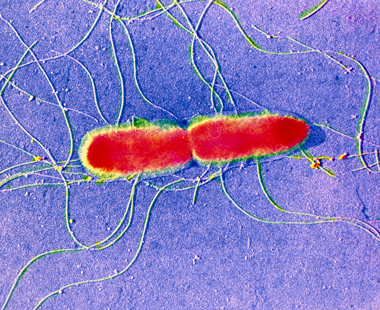7.1 Pathogenic bacteria
As well as the bacteria that are found naturally in river water and that are essential for the natural cycle of nutrients, there may be other, less desirable bacteria. Pathogenic bacteria (such as Salmonella typhi, Figure 7) can cause disease in a variety of organisms, including humans. Since the presence of pathogenic bacteria is generally due to the activities of humans, it constitutes a form of pollution. Non-pathogenic bacteria, by definition, are harmless; indeed, as already mentioned, they can be beneficial and form an essential part of the aquatic ecosystem.
Effluents from sewage treatment works contain some pathogenic bacteria, but in far smaller numbers than in incoming sewage since the sewage treatment processes will generally eliminate more than 99% of them.
Since pathogenic bacteria are accustomed to human body temperature (about 37 °C), they do not flourish in river water and die off relatively quickly.

